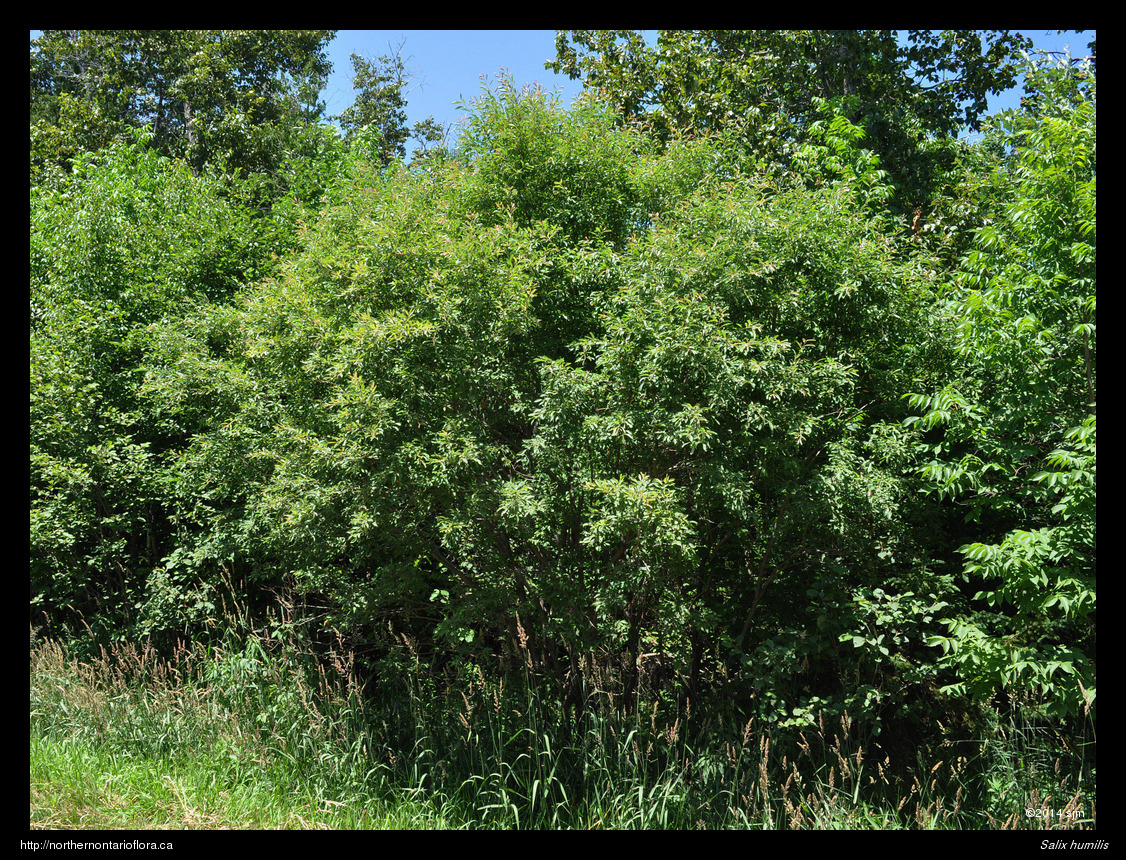
|
Northern Ontario Plant Database 
Plant DescriptionSalix humilis MarshallEn: upland willow, grey willow, prairie willow, small pussy willow
Salicaceae (Willow Family) General: Medium-sized deciduous shrubs, 1—3 m tall. Salix humilis var. humilis is the variety of upland willow that occurs in Canada. Stems/twigs: Twigs are yellowish-brown to grayish-brown and downy, with short gray hairs; buds alternate, with a single orange to reddish-brown bud scale. Young stems and winter twigs are finely hairy, but older stems are smooth (glabrous). Leaf scars are narrowly U- or V-shaped with 3 bundle trace scars. Leaves: Alternate, simple, pinnately-veined, petiolate, and stipulate. Petioles are 3—7 mm long and downy; stipules of early leaves small or lacking; late leaves have large leaf-like stipules. Leaf blades are narrowly elliptic, oblong, oblanceolate, or obovate, 5—10 cm long by 1.3—3 cm wide. Emerging leaves are often reddish and densely hairy above with short white to grayish hairs, but become smooth with age (glabrate); mature blades are dark green, glabrous, and somewhat shiny above, with deeply impressed veins that give the blades a rough (rugose) texture; lower blade surfaces are glaucous and woolly with matted white to grayish hairs, and have a conspicuous pale yellow midvein. Leaf bases are tapering (cuneate), apices are pointed (acute to acuminate); margins are flat to revolute, and entire to coarsly toothed (serrate). Leaves turn bronze to yellow in autumn. Flowers: Unisexual, male and female catkins occur on different shrubs (dioecious); flowering catkins are erect, hairy, and emerge just before or with the leaves. Male (staminate) catkins are ovoid and 1.4—3.5 cm long by 0.7—2 cm wide; each male flower has 2 stamens with yellow to dark red anthers and glabrous filaments. Female (pistillate) catkins are short-cylindrical, woolly, and 2—5 cm long by 0.5—2 cm wide; each female flower consists of a hairy gray pistil, a short style, and 2 stigmas. Floral bracts of both male and female flowers are oblong, dark brown to black, 1.2—2 mm long, with silky hairy on the outer surface. A single nectary is present in each flower, situated between the stamens or pistil and the axis of the catkin. Fruit: Small ovoid to pear-shaped hairy capsules, each 6—9 mm long, with an elongate beak, on a short stalk (stipe), 1—2.5 mm long. Willow capsules split along 2 lines; the halves recurve to expose minute seeds, which have a woolly coma at the top to aid dispersal by wind. Habitat: In our area, the upland willow is usually found on dry sandy or rocky soils in open forests, often growing with jack pine, and along roadsides and rights-of-way; in the Midwest, this species is typical of prairie habitats. The upland willow in native to eastern North America and has a Canadian range that extends from Newfoundland and Labrador to Manitoba. It occurs throughout the forested regions of Ontario, including the Algoma District. Similar Species: The upland willow (Salix humilis Marshall) is similar in appearance to the pussy willow (Salix discolor Muhl.), but pussy willows prefer wetter habitats and their lower leaf surfaces are glabrous and strongly glaucous. Back to species list |
||||||||||||||||||||||



























